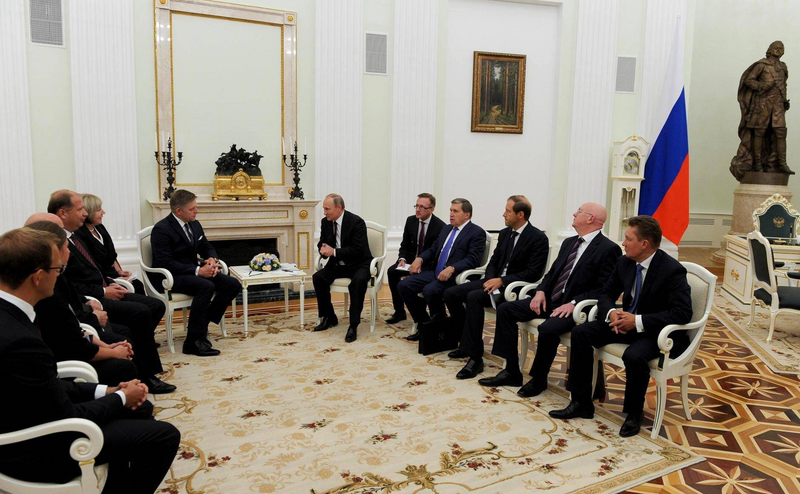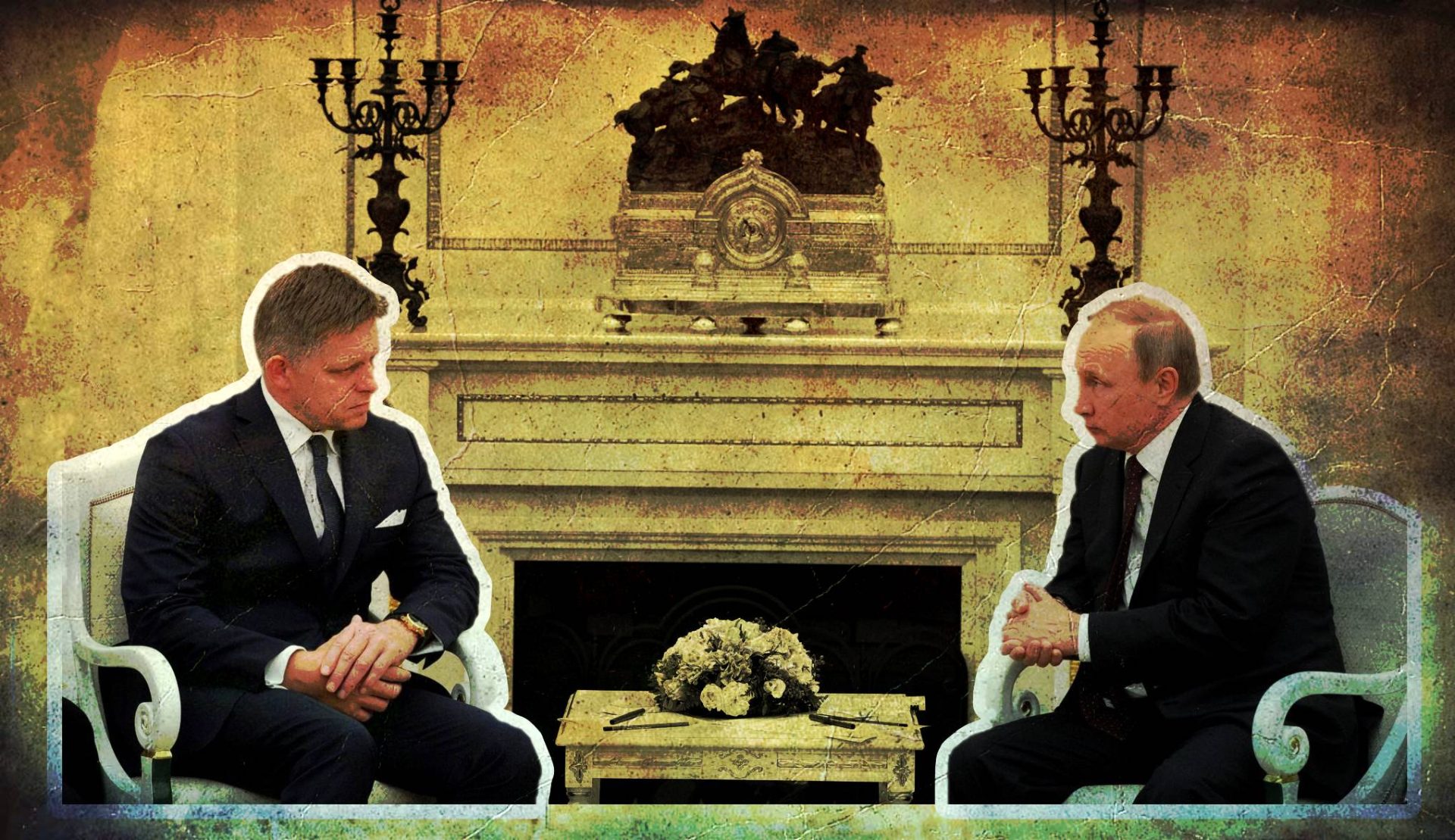Illustration: ICJK, kremlin.ru 2025-01-23
Illustration: ICJK, kremlin.ru 2025-01-23
Prime Minister Robert Fico has long garnered more “reactions” (likes, hearts, little emoji faces of surprise) to his Facebook posts than any other Slovak politician. But after his meeting with Russian President Vladimir Putin, experts say he has seen an unnatural increase in interactions, with the average number of reactions to his posts rising several times. ICJK’s analysis showed that 21 percent of the comments analyzed under a randomly selected Fico video after his Kremlin visit came from accounts showing signs of inauthenticity, double the number from our analysis last year.
“Yesterday, on the first day of 2025, Ukrainian President Zelensky started deliberately damaging Slovak public finances and harming the entire European Union,” Robert Fico told his supporters on Facebook from a luxury hotel suite in Hanoi, Vietnam, on January 2, 2025. Shortly after his meeting with Russian President Putin, he repeatedly attacked Ukraine and its president in social media posts: “President Zelensky, with his unilateral decision to stop gas transit through Ukraine towards Slovakia and other European partners, is depriving Slovakia of almost €500 million a year that we would have earned in transit fees. The entire European Union will pay 60 to 70 billion euros in higher gas prices for electricity,” Fico claimed. Some of the claims in his video have since been challenged by experts and the Slovak opposition.
By the time the original Slovak version of this article was published, Fico’s video from January 2 had received 10,000 comments, 31,000 likes, 4,500 shares and had been seen by 827,000 users. We have analyzed the approximately 9,000comments it garnered in less than a week (from the day it was posted until January 7). The Investigative Centre of Ján Kuciak found that 21 percent of the analyzed comments under the video show signs of inauthenticity.
Fico’s Facebook account gained over 6,000 new followers after the meeting with Putin. The number grew from over 309,000 on December 21, the day before the meeting with the Russian president, to 315,932 on January 13. The increased interaction on the prime minister’s profile was first pointed out by marketer Tomas Pjonek on LinkedIn. “Fico has Facebook like a world celebrity! In recent months, we can see that the more Fico’s cabinet struggles, the more likes Robert gets on Facebook,” he wrote.
Last year’s ICJK analysis already indicated that Prime Minister Robert Fico has an average of 10 percent inauthentic comments under his Facebook posts. But the post after the meeting with Putin seemed to have more than double that — up to 21 percent.

Robert Fico at a meeting with Russian President Vladimir Putin in Moscow. Source: kremlin.ru
“The increase in the proportion of comments from profiles with marks of inauthenticity from 10 percent, from the ICJK’s last analysis, to 21 percent may indicate some type of coordinated activity. Smer has a history with fake debaters, it would be nothing new,” Jakub Goda, a columnist and social media expert, told ICJK. He added that Russian propaganda activities on social networks are well documented and it would be natural if Robert Fico’s profile became more attractive to them after Fico’s meeting with Putin.
Of the more than 3,000 comments we analyzed under the video, 336 were written in Czech. In our previous analysis, under a post from September 17, 2024, where Robert Fico attacked the chairman of the Progressive Slovakia party Michal Šimečka, we identified only 38 Czech comments. In contrast, 1,203 Czech comments appeared under the first video Fico posted after the assassination attempt in Handlová.
The increase in foreign comments may also indicate that topics such as the assassination or Ukraine have a foreign spillover appeal, while the attacks on Šimečka remain largely domestic.
“It seems that when it comes to topics with an international overlap, Fico also attracts some pro-Russian Czechs, who made up 10 percent of all comments. A similar link between the Slovak and Czech online space was also seen in some of the viral misinformation about Ukraine, or earlier during the Covid pandemic,” Goda explained.
One fifth of profiles show signs of inauthenticity
The video of Robert Fico, which he recorded in Hanoi, Vietnam, and published on January 2 2025, was chosen randomly for analysis. We used the Esuit tool to download the comments. At the time of our analysis, on January 7, Facebook indicated that there were more than 9,000 comments under the video. The tool downloaded 3,187 of them. Esuit downloads comment sub-threads up to five replies. Thus, long comment threads in which the same people respond to each other dropped out of the analysis. Additionally, some of the comments that did not make it into the analysis may have been hidden by the administrator of Fico’s profile.
More than 3,000 of the analyzed comments were written by 2,429 unique Facebook profiles, some of which commented on Fico’s video more than once. The most comments from any one person (19 comments) were written by a man from the Czech Republic. Paradoxically, he defended Ukraine and attacked people who, in his opinion, fell for Russian propaganda.
One in five comments (687 out of the 3,187 comments analyzed) under Fico’s video were written by profiles that showed signs of inauthenticity. These profiles had some combination of a fake name, photo, lack of friends or a URL address that differed from the account name. In total, 471 such inauthentic profiles posted comments.
“But I do not assume that these comments from inauthentic profiles are the main explanation for Fico’s success on Facebook. I think that the fact that the meeting with Putin but also the messages to Zelensky are significant political moments across Europe and Fico communicates them essentially exclusively through Facebook, which is his primary communication channel, plays a significant role. Another important factor is the disciplined and grateful target audience that Smer has on Facebook,” said social media expert Jakub Goda.
When ICJK did a similar analysis last year, we searched for neutral profiles in the comments under Robert Fico’s five Facebook posts. We compared results from that analysis to the comments under Fico’s video after his visit to the Kremlin. Of the posts analyzed in the fall of 2024, the one closest to Fico’s Vietnam video was a post from September 17, 2024, where Fico criticized Progressive Slovakia chairman Michal Šimečka. Our analysis indicated that 229 inauthentic accounts were featured in the comments under that video. That is still 242 fewer accounts than we identified under the January 2025 video.
An Ipsos survey suggests that Smer voters are more active and share and comment more on posts than voters of liberal parties. “Sharing in a number of Facebook groups, which often have thousands or even tens of thousands of users, can also play a significant role. In the long term, of course, it is aided by hate speech and conspiracy theories, which is the basis for success in certain target groups of contemporary Facebook,” Goda said.
Czech accounts come to help
Robert Fico posted 453 posts on Facebook in a year — from January 9, 2024 to January 9, 2025 — according to data from Gerulata, a research and analysis tool. The kind of increase in the number of interactions seen after the Russian president’s visit was also achieved when Robert Fico’s profile posted its first video after the May assassination attempt in Handlová, which Fico posted on 5 June 2024. The video went up under the title “Forgive and warn.”
In both cases, the video was also covered by foreign media, which may have helped the virality of the post. “It is natural that politicians and topics that evoke emotions and seem to make people react in some way get more comments,” social media expert and journalist Filip Struhárik told ICJK.
Robert Fico set up his official Facebook page in 2017. Since April 2019, Fico and the Smer-SD party have invested €133,000 in advertising on Facebook. He has seen a similar increase in fan engagement for other major events, such as during the 2023 elections and after the attempted assassination in 2024.
An analysis of the comments under Fico’s video from January 2 indicates that the majority of the comments, i.e. 2447, were in Slovak and 336 were in Czech. There were 114 comments in another language.
We compared the data from the post after the Kremlin visit with the first video that Robert Fico published after the Handlová shooting, which was similarly successful. We also compared it with the post from September 17, which we first analyzed in autumn 2024. The Esuit tool pulled 3,802 comments from this post, which is a similar number to the January video, but with the difference that his video was not covered by foreign media. The post after the Handlová shooting received the most foreign comments, including Czech comments. Above all, they wished Fico a speedy recovery.
“Comments contribute to the framing of social issues. In doing so, the people who write them do not have to be real and do not have to base their opinions on reality or facts. They simply flood and poison the public discourse with their narratives,” says Peter Jančárik, an expert on disinformation.
One profile also comments on multiple posts
We also looked at the profiles that commented on Fico’s video from January 2 and found that some of them also showed signs of inauthenticity — and were also in the comments under Fico’s six other posts after his meeting with Vladimir Putin.
Of the accounts we marked as inauthentic, 360 commented only on Fico’s video from January 2, while 156 profiles also commented on one other post on Fico’s profile, and only five Facebook accounts we determined to be inauthentic commented on all six posts.
According to Miroslav Mikuláš of the elv.au platform, inauthentic accounts can seek to dominate attention in the online space. “These profiles are very keen to give the impression that the majority of the population agrees with their views, thereby trying to create doubt among those who oppose them. They don’t necessarily have to convince them of their truth, it’s all about planting feelings of frustration and helplessness, in short, to demotivate them in presenting their views and thus gain even more dominance in the online space,” explained Mikuláš.
The article was originally published on ICJK.
Subscribe to “Goulash”, our newsletter with original scoops and the best investigative journalism from Central Europe, written by Szabolcs Panyi. Get it in your inbox every second Thursday!
Karolína Kiripolská is a Slovak journalist working at the Investigative Center of Jan Kuciak (ICJK). Previously, she worked at the Slovak independent outlet Denník N, where she began as a reporter and later served as a web editor. Karolína has experience in fact-checking, having worked for US company LeadStories, verifying information for platforms like TikTok and Meta.







